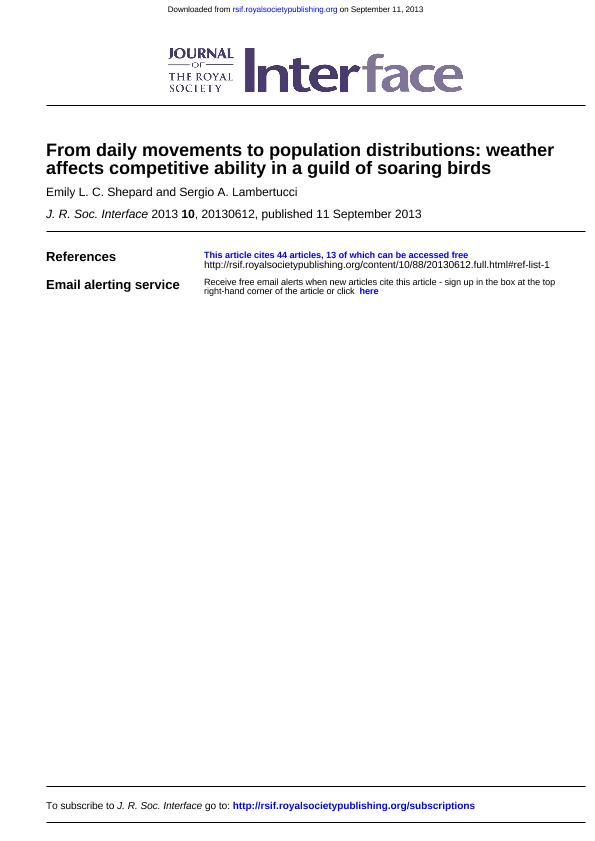Mostrar el registro sencillo del ítem
dc.contributor.author
Shepard, Emily L. C.
dc.contributor.author
Lambertucci, Sergio Agustin

dc.date.available
2016-07-27T20:54:17Z
dc.date.issued
2013-11
dc.identifier.citation
Shepard, Emily L. C.; Lambertucci, Sergio Agustin; From daily movements to population distributions: weather affects competitive ability in a guild of soaring birds; The Royal Society; Journal Of The Royal Society Interface; 10; 88; 11-2013; 1-7
dc.identifier.issn
1742-5662
dc.identifier.uri
http://hdl.handle.net/11336/6748
dc.description.abstract
The ability of many animals to access and exploit food is dependent on the ability to move. In the case of scavenging birds, which use soaring flight to locate and exploit ephemeral resources, the cost and speed of movement vary with meteorological factors. These factors are likely to modify the nature of interspecific interactions, as well as individual movement capacity, although the former are less well understood. We used aeronautical models to examine how soaring performance varies with weather within a guild of scavenging birds and the consequences this has for access to a common resource. Birds could be divided broadly into those with low wing loading that are more competitive in conditions with weak updraughts and low winds (black vultures and caracaras), and those with high wing loading that are well adapted for soaring in strong updraughts and moderate to high winds (Andean condors). Spatial trends in meteorological factors seem to confine scavengers with high wing loading to the mountains where theyout-compete other birds; a trend that is borne out in worldwide distributions of the largest species. However, model predictions and carcass observations suggest that the competitive ability of these and other birds varies with meteorological conditions in areas where distributions overlap. This challenges the view that scavenging guilds are structured by fixed patterns of dominance and suggests that competitive ability varies across spatial and temporal scales, which may ultimately be a mechanism promoting diversity among aerial scavengers.
dc.format
application/pdf
dc.language.iso
eng
dc.publisher
The Royal Society

dc.rights
info:eu-repo/semantics/openAccess
dc.rights.uri
https://creativecommons.org/licenses/by-nc-sa/2.5/ar/
dc.subject
Movement Ecology
dc.subject
Cost of Transport
dc.subject
Energy
dc.subject
Competition
dc.subject.classification
Ecología

dc.subject.classification
Ciencias Biológicas

dc.subject.classification
CIENCIAS NATURALES Y EXACTAS

dc.title
From daily movements to population distributions: weather affects competitive ability in a guild of soaring birds
dc.type
info:eu-repo/semantics/article
dc.type
info:ar-repo/semantics/artículo
dc.type
info:eu-repo/semantics/publishedVersion
dc.date.updated
2016-07-22T18:51:33Z
dc.journal.volume
10
dc.journal.number
88
dc.journal.pagination
1-7
dc.journal.pais
Reino Unido

dc.description.fil
Fil: Shepard, Emily L. C.. Swansea University; Reino Unido
dc.description.fil
Fil: Lambertucci, Sergio Agustin. Consejo Nacional de Investigaciones Científicas y Técnicas. Centro Científico Tecnológico Patagonia Norte. Instituto de Investigación en Biodiversidad y Medioambiente; Argentina
dc.journal.title
Journal Of The Royal Society Interface

dc.relation.alternativeid
info:eu-repo/semantics/altIdentifier/doi/http://dx.doi.org/10.1098/rsif.2013.0612
dc.relation.alternativeid
info:eu-repo/semantics/altIdentifier/doi/10.1098/rsif.2013.0612
dc.relation.alternativeid
info:eu-repo/semantics/altIdentifier/url/http://rsif.royalsocietypublishing.org/content/10/88/20130612
Archivos asociados
